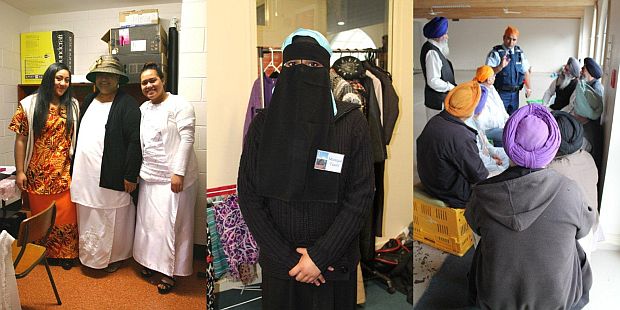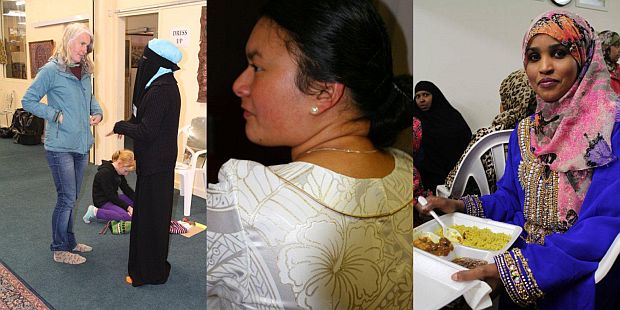How do you dress?

Gallery: How do you dress?
Pule tasi or niqab? Like the diversity of our cultures, New Zealand’s dress code is changing all the time. These days you can wear your hijab to work without question, although Sikh’s still need to consider covering their Kirpan (sacred knife) to avoid police call-outs from the public. I decided to visit a Church, Mosque and a Sikh Temple to learn about our changing dress sense.
It’s Father’s Day as Reverend Perema Leasi guides the congregation at the Pacific Island Presbyterian Church in Porirua, and the children from the Sunday school are singing hymns in Samoan, Tokelauan and English with gusto. The flower patterns woven into the white, wide-brimmed hats are gorgeous. It’s very festive. Caroline Mareko, the Sunday School teacher at the church is my guide.
Caroline introduces me to Peta Tamati, the Choir Leader. Peta explains the pule tasi; the formal dress worn by Pacific Island women. The pule tasi consists of a long skirt – appropriately down to the ankles – definitely not above the knees, accompanied by a shirt or top with sleeves. It’s all white today because it’s Communion Sunday but normally the congregation can wear all manner of colours and patterns associated with your homeland, such as the distinctly floral (especially hibiscus) patterns of Rarotonga.
The hats are described by Peta, “like you’re going to the races”. They have wide brims with floral decorations in silk. Traditionally the hats are made with finely woven pandanus, in the style of weaving according to the Island. I spot a couple of beautiful examples from the Cook Islands, standing out against the sea of white hats in the congregation.
Next Caroline introduces me to Matai Lio Fanaea Olai Paese, a community leader and the Church Session Clark. Matai Lio explains the formal male dress, the le faitaga. It consists of the lavalava with a suit jacket and tie. Two types of lavalava that men will wear will have either a clip or a belt to fix this wrap-around to the waist. The length of lavalava falls to the shins.
The men are also in white today but normally their lavalava would be a solid colour for church, without patterns like the day-to-day lavalava. Traditionally lavalava were made from tapa cloth, hibiscus tree bark that has been pounded into a fine cloth or woven from pandanus leaves but these days the cloth is imported loom from overseas, awaiting patterning and designs in the Islands. Men don’t need to wear hats to church, says Matai Lio, only women.
Matai Lio informs me that Samoan men may sport traditional tattoos with distinctive patterns called Pe’a across their whole torso and down their legs. Women will sport the malu across their thighs. Tattooing is an ancient tradition, part of the Samoan formal dress. Caroline tells me that the tattooing is done with a fine chisel and ink made from traditional plant material – the process is a painful rite of passage back in Samoa.
Across the country at the Manurewa Sikh Temple in Auckland the community have gathered to prepare langar or shared lunch, a daily ritual that involves most of the community, young and old. Anybody is welcome to participate, members of the public will find a warm welcome, but first you must take your shoes off at the temple door and don a chunni (head covering).
My guide is Sergeant Gurpreet Arora. The elderly Sikh men gathered are asking this Asian Liaison Police Officer and fellow Sikh about some of their traditional dress and whether they can wear this in public. Specifically they’re referring to the traditional Kirpan (sacred ornamental knife). Sergeant Arora suggests that they should not wear this in public if possible, so that the police don’t receive call-outs from the unknowing public. The five sacred “K’s” or articles of faith are worn by Sikh men at all times. The five sacred K’s: firstly there is Kesh or uncut hair, then the Kanga or small wooden comb, the ornate dagger Kirpan often made of silver, the Kara – a bangle made of iron or steel and the Kachera, the sacred undergarment.
Back in Wellington while attending open day at the Kilbirnie Mosque I am introduced to the niqab or full body covering for women. Hafsa from Sri Lanka chooses to wear niqab. For her this is a personal choice but she tells me that hijab (head covering) is compulsory for women in the Mosque.

The Muslim community have turned up to welcome the public with food stalls and activities, a chance for the people to better understand the Islamic faith and way of life.
For Islamic women across the globe are different cultural styles of dress and head covering depending on your country of origin. Your hijab can be made from sumptuous cloth and luminous colours common to the Somalian community or a starkly monotone full body covering, completely black like the niqab with just eyes showing or completely veiled in blue like the burka.
The burka is most prevalent in countries like Iraq, Afghanistan and Saudi Arabia. The Chador (full head covering showing the face) is common to countries like Egypt, Iraq and Pakistan and the al-Amira (head covering in white), is common also to Pakistan, Turkey, Tunisia and Lebanon. The colourful hijab is worn across the globe, most commonly seen in Tunisia and countries like Malaysia as well as Turkey.
But in the middle of the Kilbirnie Mosque I’m bedazzled by a cobalt blue hijab worn by a woman from Somalia. I can’t resist asking where the pashmina are being sold.